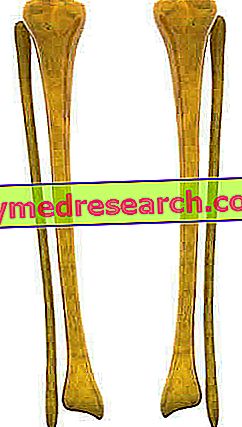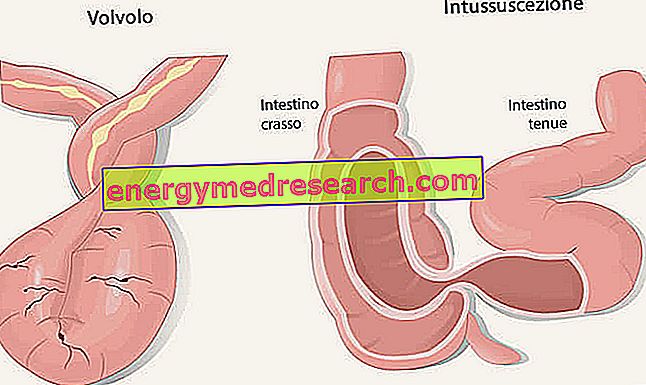Generality
In the human being, the bones of the leg are the bony elements that constitute the skeleton of the anatomical portion of the lower limb, between the thigh and the foot.

Belonging to the category of long bones, tibia and fibula are parallel to each other, with the former situated in a medial position with respect to the latter.
What are leg bones?
The leg bones are, in the human being, what constitutes the skeleton of the lower limb portion between the thigh and the foot .
The bones of the leg are the tibia and the fibula (or fibula ).
BRIEF DEFINITION OF LEG
The leg is the anatomical region of the human body between the thigh and the foot.
Both at the border between the thigh and leg and at the border between leg and foot, there is an articulation: in the first case, it is the knee joint; in the second case, however, it is the ankle joint.
In anatomy, proximal and distal are two terms with the opposite meaning.
Proximal means "closer to the center of the body" or "closer to the point of origin". Referring to the femur, for example, it indicates the portion of this bone closest to the trunk.
Distal, on the other hand, means "farther from the center of the body" or "farther from the point of origin". Referred (always to the femur), for example, it indicates the portion of this bone furthest from the trunk (and closer to the knee joint).
Anatomy
The tibia and fibula leg bones are two equal, longitudinal and parallel bone elements.
Both belonging to the category of long bones, they adjoin the femur, superiorly, and the astragalus, inferiorly. Femur and astragalus are, respectively, the only bone that constitutes the skeleton of the thigh and one of the 7 tarsal bones of the foot.
Tibia
Located on the inner side of the leg, in a medial position with respect to the fibula, the tibia is a long bone particularly broad at the ends and somewhat slender in the central portion.
Anatomy experts divide the tibia into three main bone regions: the proximal end (also called the proximal epiphysis), the body (or diaphysis) and the distal end (also known as the distal epiphysis).
In anatomy, medial and lateral are two terms of opposite meaning, which serve to indicate the distance of an anatomical element from the sagittal plane . The sagittal plane is the anteroposterior division of the human body, from which two equal and symmetrical halves are derived.
Mediale means "near" or "closer" to the sagittal plane, while lateral means "far or" farther "from the sagittal plane.
NEXT END OF TIBIA
The proximal end of the tibia is the bone portion closest to the femur.
Actively involved in the knee joint, it is an enlarged area, with two prominent prominences, which are called medial condyle and lateral condyle . The medial condyle is on the inner side of the leg, while the lateral condyle is on the external side.
The upper surfaces of the two condyles give rise to a characteristic area of the tibia, the so-called tibial plate . At the center of the tibial plateau take place two small pyramidal bone processes, which act as a point of attachment for the terminal ends of the two cruciate ligaments (anterior and posterior) of the knee and for the two meniscuses (always of the knee). These two pyramid-shaped bone processes are known as intercondylar diuretic tubercles and together form the so-called intercondylar eminence .
The intercondylar eminence fits perfectly into a concavity, present on the femur and which takes the name of intercondylar fossa .
Then changing position, on the anterior surface of the proximal end of the tibia, just below the apex of the two condyles, there is a relief, perceptible to the touch, identified with the name of tibial tuberosity . The tibial tuberosity is the insertion point for the terminal head of the patellar tendon . The patellar tendon is a formation of fibrous tissue, which continues the tendons of the quadriceps femoral muscle and connects the knee patella to the tibia.
More or less at the same level as the tibial tuberosity, but in a medial position, another prominence develops, called goose paw . The goose leg welcomes the terminal heads of three muscles: sartorius, gracile and semitendinosus.
For more information on the sartorius, gracilis, semitendinosus and femoral quadriceps muscles, readers can consult the article dedicated to the muscles of the thigh.
BODY OF THE TIBIA
The body of the tibia is the central section of the bone in question; it is included between the proximal end (above) and the distal end (below).
In cross section, the body of the tibia is triangular in shape and has three surfaces: a medial, a lateral and a posterior. Particularly interesting from the anatomical point of view are the lateral surface and the posterior surface.
- On the lateral surface, the so-called interosseous membrane takes place, which binds together the tibia and the fibula.
- The posterior surface has a bone crest, with an infero-medial course (that is, it runs downwards and towards the inside of the leg), from which originates the soleus muscle of the calf. The anatomists call this bone crest with the name of the soleus line .
Compared to the proximal (and distal) end, the body has a decidedly lower width.
DISTAL END OF TIBIA
The distal end of the tibia is the bone portion closest to the foot.
Like the proximal end, it is a visibly enlarged area with characteristics that allow it to articulate with the tarsal bones of the foot and form the ankle.
The most important anatomical components of the distal end of the tibia are 4:
- The lower margin, which, together with the lower margin of the fibula, makes up the region known as mortar . The mortar is, in fact, a bone cavity, into which the talo (or astragalus) of the foot is inserted. The talo is one of the 7 bones that make up the tarsus of the foot .
- The medial malleolus . It is a bone process that develops in the inferior-medial direction, therefore on the inner part of the leg, downwards. Its main function is to guarantee stability to the ankle joint.
As will be seen, another malleolus, with equal function, is present on the distal end of the fibula.
- A groove in the posterior seat, through which the tendons of the posterior tibial muscle flow.
- The fibular incisura . It is a small shower recess that houses and hooks the distal end of the fibula. Resides in a lateral position.
The joints that see the tibia involved:
- Knee joint
- Ankle joint
- Upper tibio-fibular joint (or proximal tibia or fibula)
- Lower tibio-fibular joint (or distal tibia or fibula)

Fibula
Located on the outer side of the leg, in a lateral position with respect to the tibia, the fibula is a long, slender bone, which maintains its slenderness from one end to the other.
As in the case of the tibia, it is anatomically divided into three regions: the proximal end (or proximal epiphysis), the body (or diaphysis) and the distal end (or distal epiphysis).
NEXT END OF THE PERONY
The proximal end of the fibula, or fibula head, is the bone portion closest to the femur (although it does not communicate directly to it).
Similar to an irregular square, the head has some characteristics of absolute relevance:
- A flattened surface, in a medial position. This surface, called the facet, serves to articulate the fibula to the tibia, precisely to the lateral tibial condyle.
- A rough ledge, in a medial position. This protrusion takes the specific name of apex or styloid process . The styloid process develops upwards and acts as a point of attachment for the terminal heads of the biceps femoris and the lateral collateral ligament of the knee.
- A series of bone tubercles, located on the anterior and posterior surfaces. Anteriorly, there are two tubercles: on one the initial end of the long peroneal muscle is inserted, while on the other one of the two ends of the anterior superior tibio-fibular ligament is attached (the other end is joined to the tibia).
Later, there is only one tubercle, which binds to itself one of the two ends of the so-called superior posterior tibio-fibular ligament (also in this case, the other end is connected to the tibia).
The anterior and posterior superior tibio-fibular ligaments hold the fibula and tibia together.
PERONE BODY
The so-called body is the central bone section of the fibula, between the proximal end (superiorly) and the distal end (inferiorly).
It has 4 edges - antero-lateral, antero-medial, postero-lateral and postero-medial - and 4 surfaces - the anterior, posterior, medial and lateral.
Among the edges, the antero-lateral border is noted, on which the interosseous membrane which holds together the tibia and fibula is still present.
DISTAL END OF THE PEARL
The distal end of the fibula is the bone portion closest to the bones of the foot (in particular the tarsus of the foot).
The first anatomical element characterizing this extremity is the so-called peroneal malleolus (or lateral malleolus ). The peroneal malleolus is a bone process that develops on the lateral margin of the fibula and contributes, together with the tibial malleolus, to the stabilization of the astragalus (the main bone of the tarsus of the foot) inside the mortar, the particular cavity located on the lower margin of the tibia.
Therefore, the second anatomical element characteristic of the distal end is the articular facet, which serves to join the fibula and the tibia together in their distal portions. This facet occupies a medial position and fits into the aforementioned fibular incisura (recess of the tibia which is very similar to the base of a shower).
The joints in which the fibula participates:
- The superior tibio-fibular joint (or proximal tibial-fibular)
- The inferior tibio-fibular articulation (or distal tibio-fibular)
- The ankle joint
- The fibrous joint (or syndesmosis), formed by the interosseous membrane
Function
The leg bones play a decisive role in the mechanism of locomotion, giving insertion to numerous muscles fundamental for the movement of the lower limbs (see leg muscles).
Furthermore, the tibia also has the task of supporting the weight of the body.
diseases
Like all bones in the human body, the bones of the leg are also fractured.



